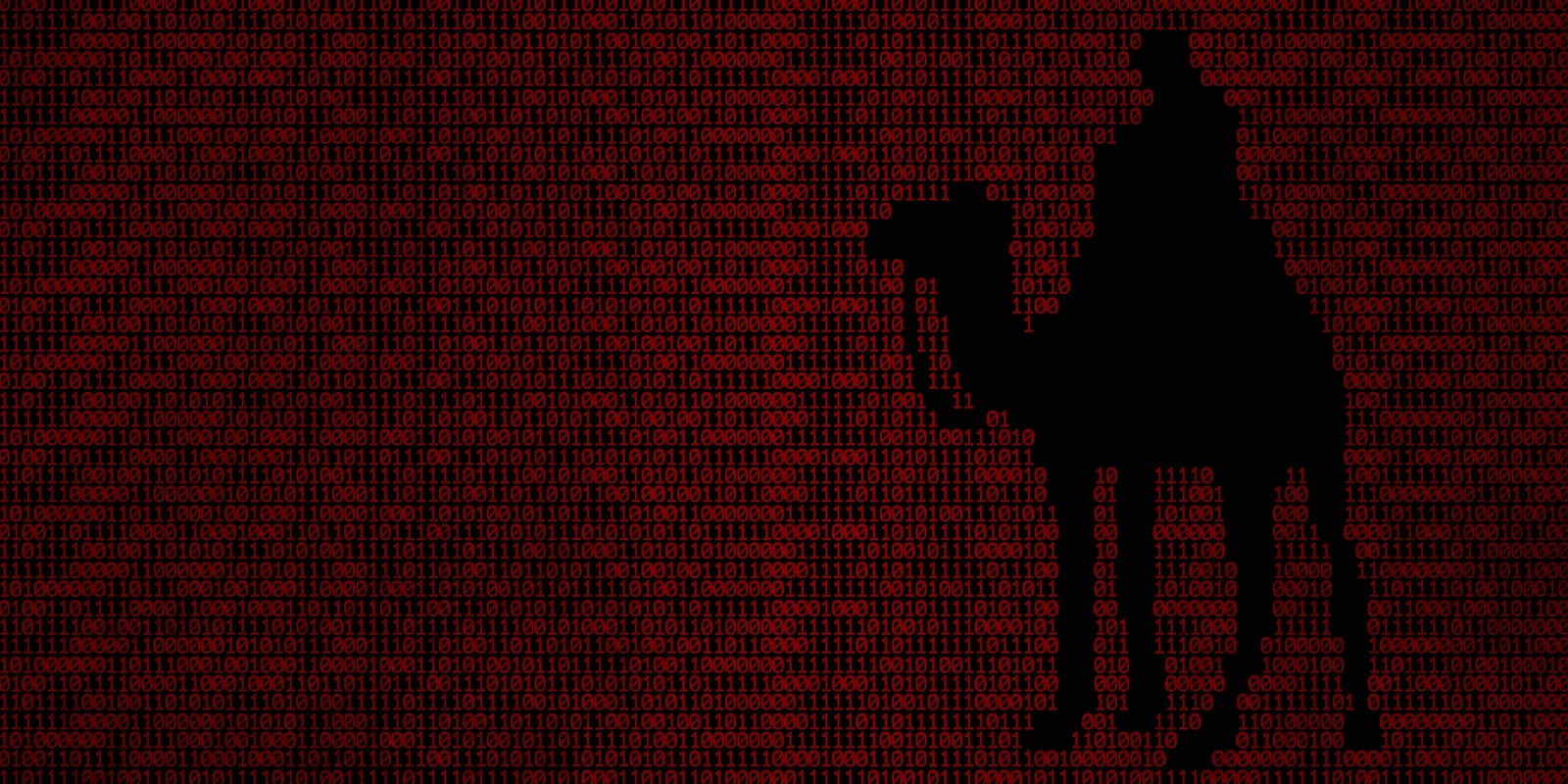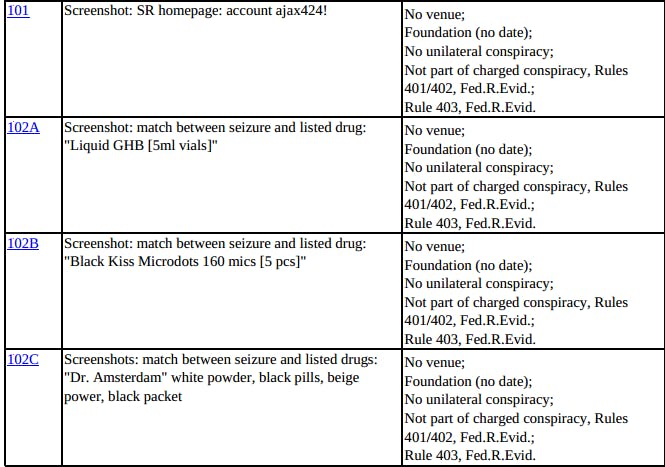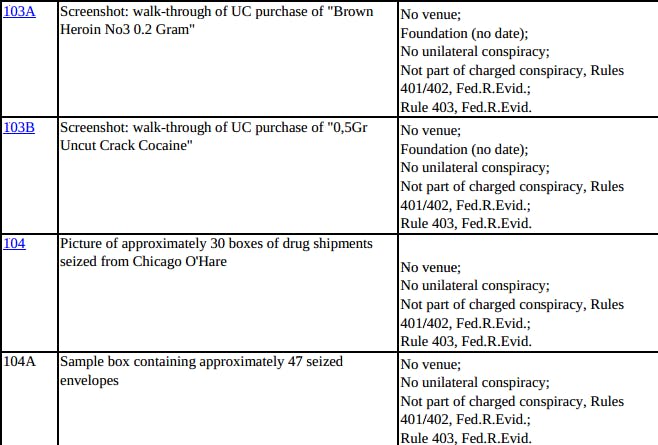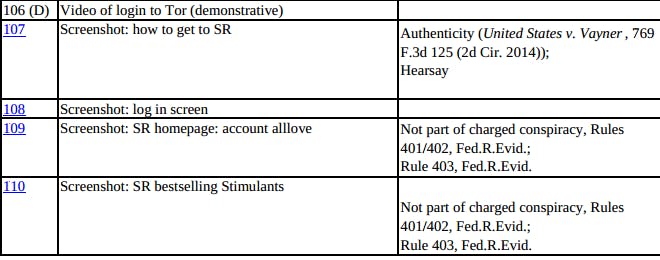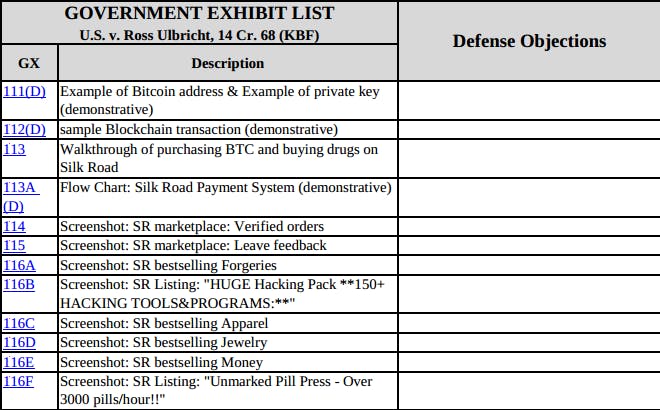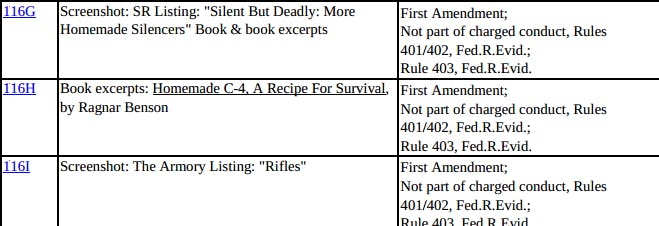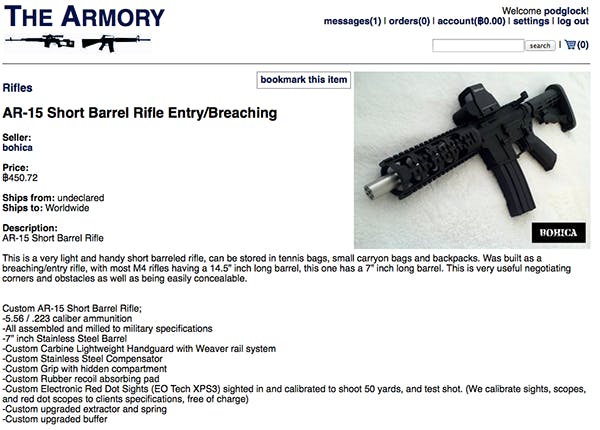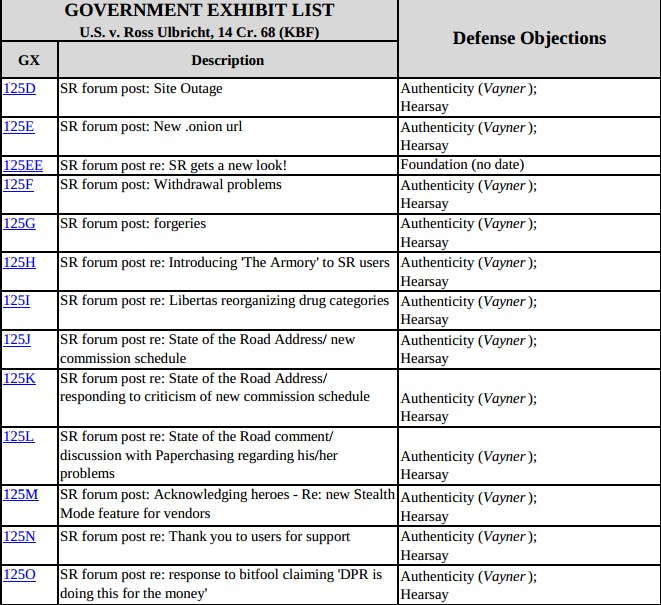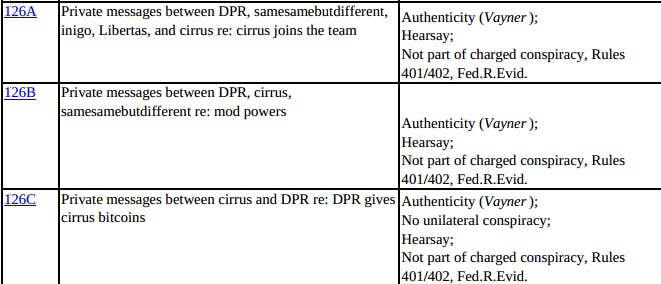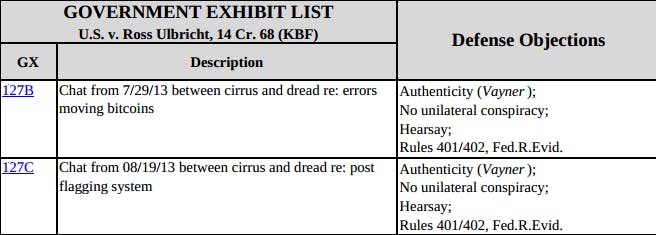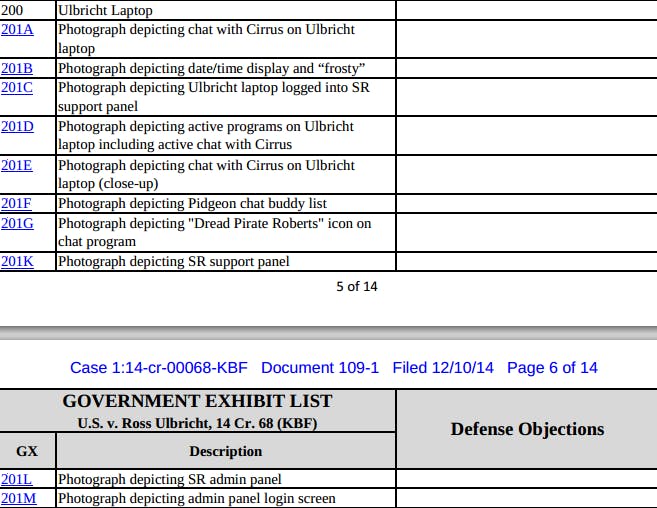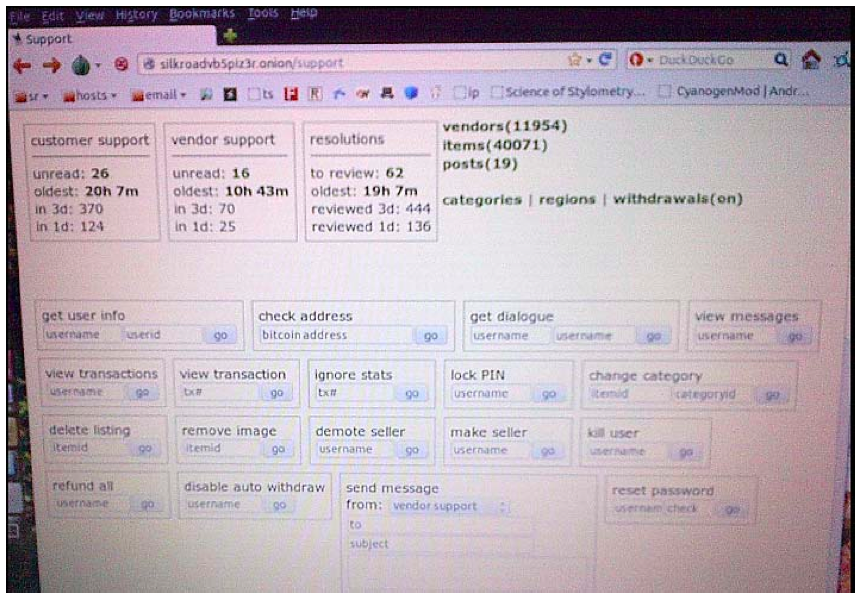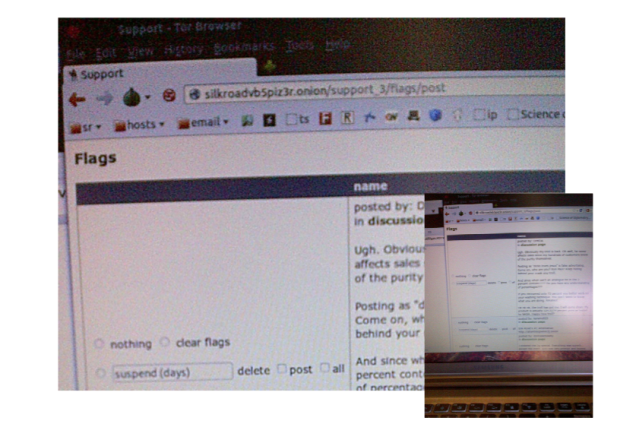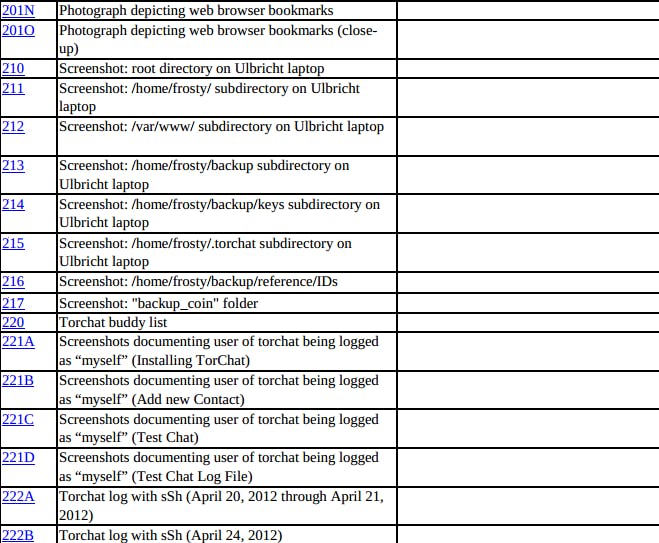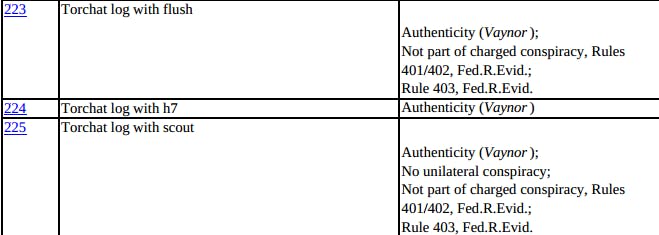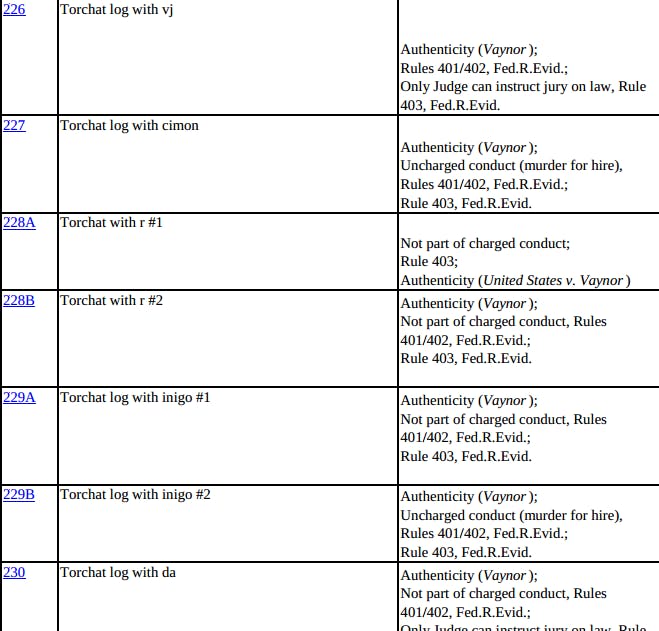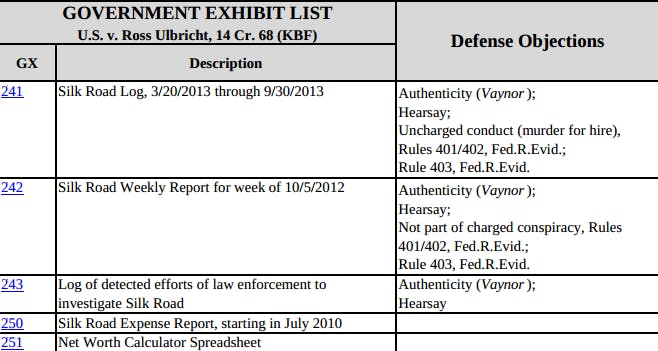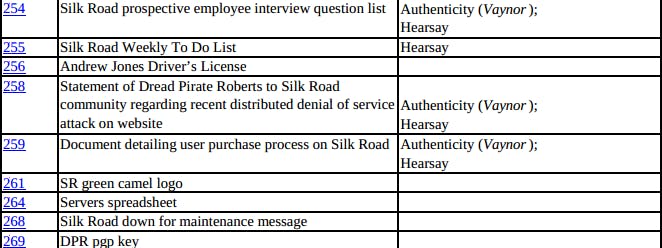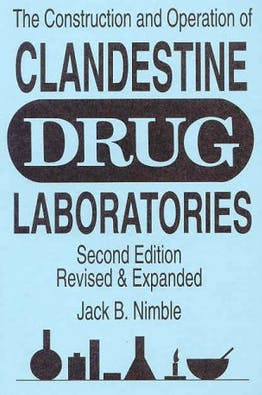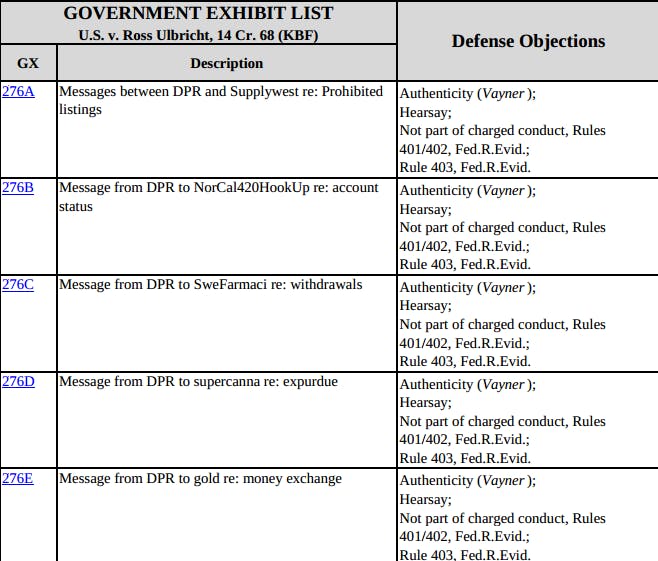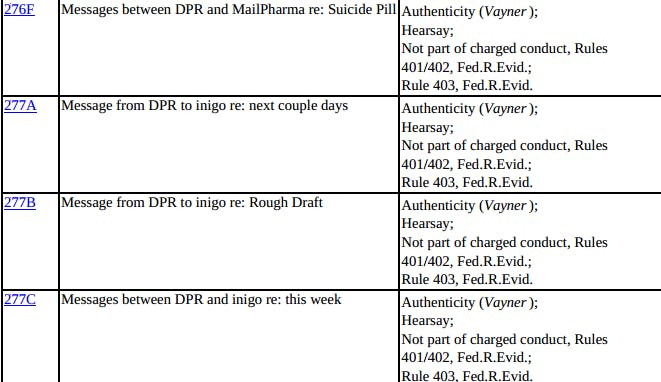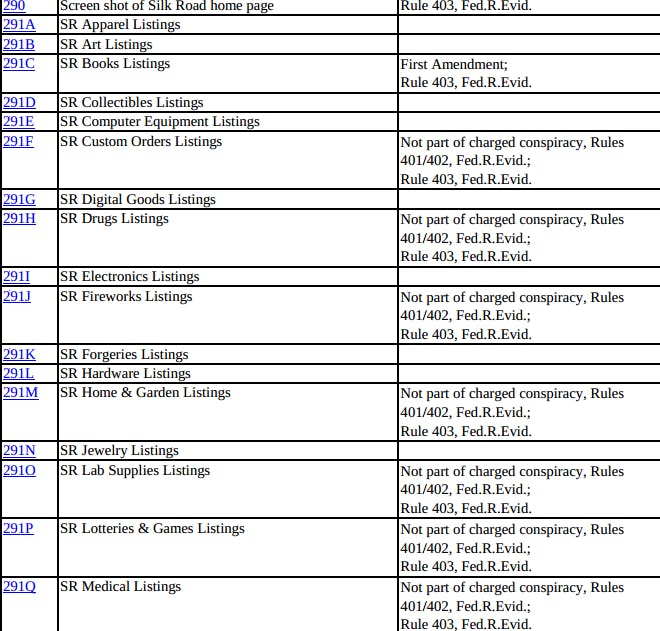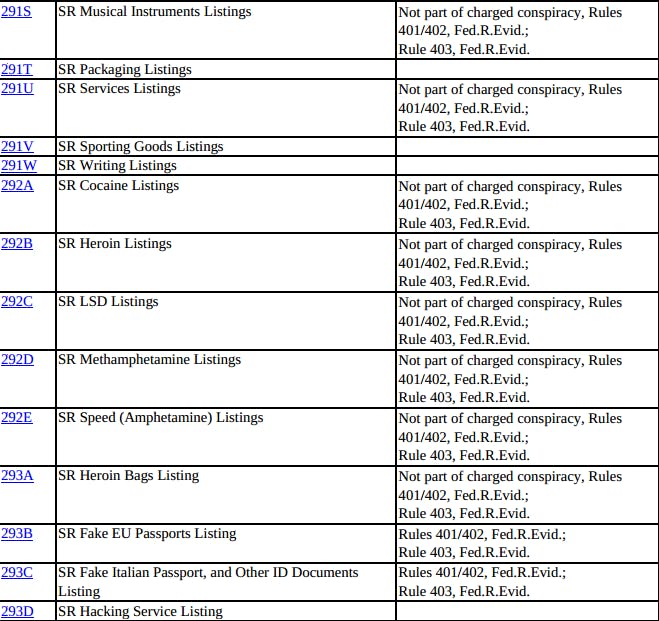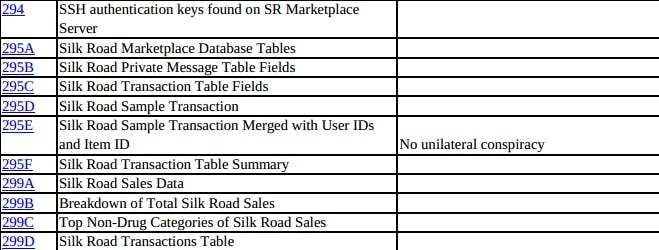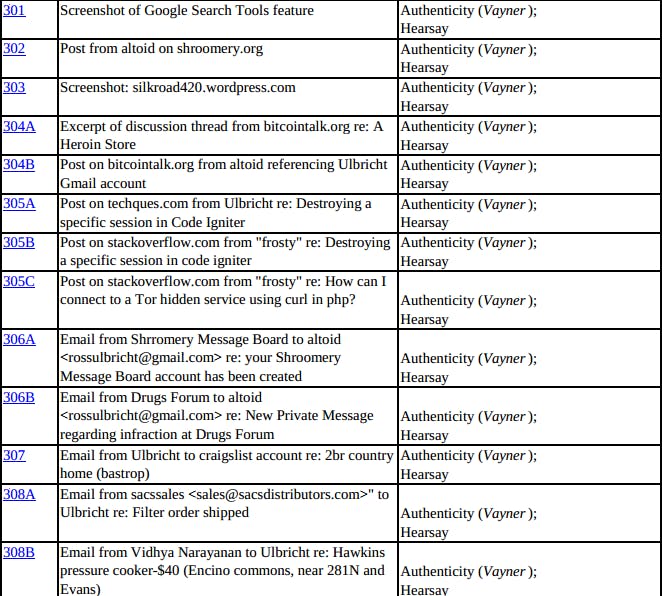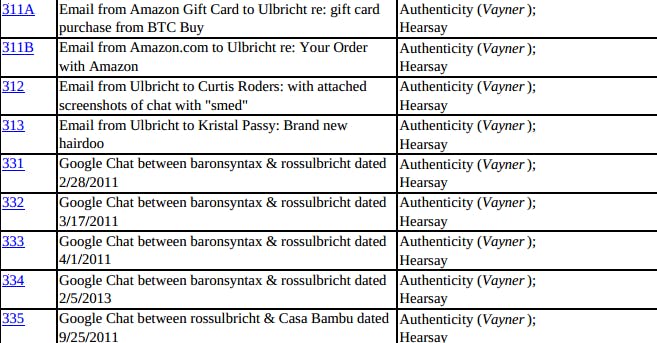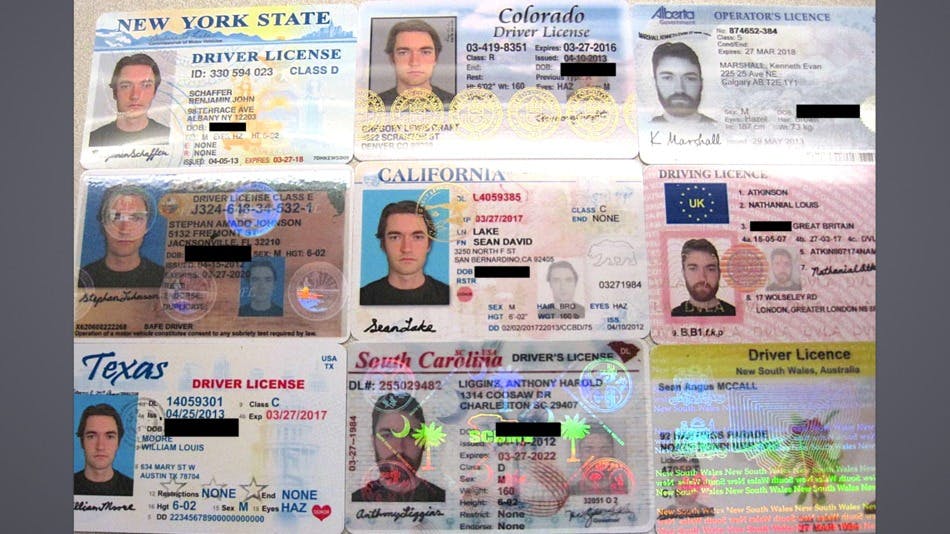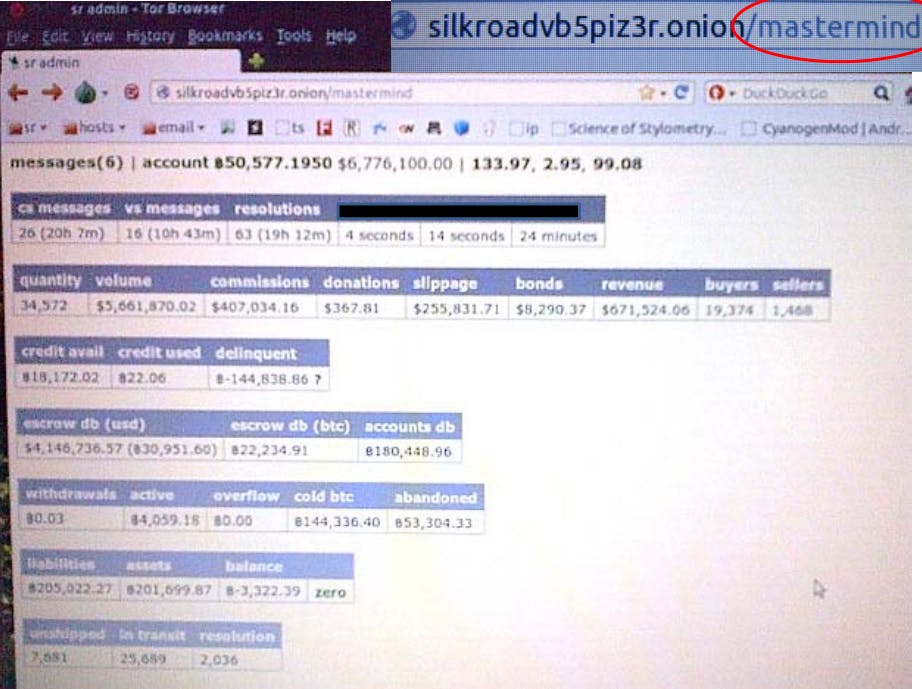With less than a month left until the trial of Ross Ulbricht begins, the Daily Dot has obtained a list of the 250 pieces of evidence that will be used by prosecutors in an attempt to prove the alleged Silk Road mastermind’s guilt. In many cases, we also have access to the actual evidence itself.
Ulbricht is being tried in New York City on counts of drug trafficking, drug trafficking conspiracy, continuing a criminal enterprise, aiding and abetting the distribution of drugs over the Internet, computer hacking conspiracy, money laundering, and fraud with identification documents. Outside of New York, multiple counts of murder for hire have been leveled at him as well. He faces a maximum potential sentence of life in prison.
It’s been over a year since Ulbricht’s October 2013 arrest, an event that catapulted Silk Road into the national spotlight and shook the Dark Net, the seedy subsection of the Internet not indexed by Google. But despite his defense team’s protests, the defense only obtained a full list of evidence exhibits in early November 2014. The list found its way to the public when defense attorney Joshua Dratel “inadvertently” filed a list of objections onto the public docket. It stood there for a week before it was placed under seal as it was originally intended to be.
We’ve posted the majority of the list with defense objections below. With the full scope of the prosecution’s case becoming clearer, we can begin to better understand how the trial may unfold.
Prologue
Based on the evidence being presented, the government appears to have chosen a broad attack against Ulbricht. They’re including several pieces of evidence that seem to have no direct connection to Ulbricht except that they’re related to Silk Road. The government’s argument is that, as the site’s alleged administrator, Dread Pirate Roberts, anything that occurred there is his fault. The defense vehemently disagrees.
In addition to drug seizures from other Silk Road dealers, the prosecutors showcase screenshots from both Silk Road’s public and private sides. One key point of the trial will be whether the defense is able to get any of it thrown out because it is difficult to verify screenshots from social media.
To be sure, however, the government is introducing a lot of evidence directly pointed at Ulbricht and Roberts. Journals, financial spreadsheets, and fraudulent IDs are but a few of the exhibits that will likely be presented.
The evidence that’s not being presented is just as telling. There appears to be no forensic documentation detailing just how the FBI first found Silk Road’s servers.
The question of just how the FBI did it—the defense has accused police of a “blatantly criminal” hack—is conspicuously unanswered. In October, the judge rejected the defense’s argument on a technicality, seemingly leaving the prosecutors free to ignore the issue from here on out.
The evidence is long, but it does give important insight into the prosecution’s strategy to convict Ulbricht, as well as the defense’s strategy to beat them back.
Act I: The set-up
The defense objects to the relevance of all of the evidence listed above. Additionally, they claim it it will cause prejudice, confusion, or a waste of time. The exact details from either side are difficult to suss out because neither the defense nor prosecuting attorneys are saying much to the press and the full explanations are still under court seal. Still, we have a pretty good idea of what’s going on here.
“Prettice Kerstdagen” means “Merry Christmas” in Dutch. Seizures at O’Hare were instrumental in the 2014 capture of a Dutchman named Cornelis Jan Slomp (also known as SuperTrips on Silk Road).
The government has made clear, despite the judge’s misgivings about an “extraordinarily broad” prosecution, that it plans on trying to hold Ulbricht accountable for all the illegal transactions that took place on Silk Road, not just the ones he directly took part in. Additionally, there are many pieces of evidence solely intended to explain and demonstrate the ins and outs of Silk Road to the jury, illustrating how these drug deals enabled by the Internet were not entirely unlike those found in the real world and Hollywood for decades.
SuperTrips has been described by police as “the world’s largest drug-trafficking vendor on Silk Road by volume of business and customer base,” so it’s no surprise the prosecutors would introduce him here.
As evidenced above, it appears the prosecution will trot out multiple major drug seizures that took place and match them up with drugs listed on Silk Road, likely in order to further demonstrate what Silk Road was enabling. It’s not clear whose drugs were seized or where and how the seizures took place.
These pieces of evidence are all under objection from the defense as irrelevant and likely to cause prejudice:
As has been well documented at this point, undercover cops were buying drugs on Silk Road. With the two pieces of evidence focused on undercover purchases (“UC purchase”), police will likely tell jurors exactly how they did it and what they received.
As with all the evidence above, the defense contends this is irrelevant—Ross Ulbricht was not the one selling these drugs, they’ll stress—and likely to cause prejudice.
Act II: The inner workings
Next, the prosecution will likely begin to explain the nuts and bolts of Tor, Bitcoin, and Silk Road: how to access it, how to navigate it, and how to find drugs. In short, Tor is anonymizing software used to connect to the Dark Net, which hosted Silk Road. Bitcoin is the pseudonymous digital cryptocurrency that powered all of the deals made on Silk Road.
A few specific pieces of evidence stand out in this group.
“Alllove” was a highly respected marijuana dealer who seemingly vanished into thin air at some point.
The “HUGE Hacking Pack” will likely be used by the prosecution to argue that not all crimes on Silk Road were victimless. The apparel, jewelry, and money exhibits will likely show off the diversity of products on Silk Road—diversity that, by the way, has only vastly increased on the Dark Net in the last year.
Finally, the pill press may be used to demonstrate that this wasn’t simply a marketplace of small buys, but one that could and did enable customers to set up big drug operations of their own.
Here the government will begin to show jurors weapons literature that was sold on the Silk Road as well as listings for buying rifles on the Armory, a short-lived spin-off market that closed down after six months.
The defense objected on numerous grounds. To start, it’s all protected by the First Amendment, they say. Second, it has nothing to do with the charges Ulbricht is facing, and finally that it’s likely to cause prejudice.
When people called Silk Road the Amazon of the Dark Net, they weren’t kidding. It was professionally run in a lot of ways, including helpful guides and customer support. This evidence could give the jurors more knowledge about how Silk Road worked on a day-to-day basis.
Act III: Dread Pirate Roberts
And now we get to the myth himself: Dread Pirate Roberts.
The prosecution’s entire case rests on linking Ulbricht to Roberts, a pseudonym used by the person or people who built and maintained Silk Road. These forum posts, written by Dread Pirate Roberts, helped build the character and base of Silk Road.
“You may be shocked to find listings here that are outlawed in your jurisdiction. That doesn’t mean Silk Road is lawless,” DPR wrote in “A few words from the Dread Pirate Roberts.” “In fact, we have a very strict code of conduct that, if given a chance, most people I think would agree with. Our basic rules are to treat others as you would wish to be treated, mind your own business, and don’t do anything to hurt or scam someone else.”
Many of the above posts help chronicle the growth and changes that Silk Road underwent in its two years of existence. Also interesting is the time at which they were posted. If the prosecutors can successfully establish a pattern that makes it likely the poster was in San Francisco, that’ll be another weapon in their arsenal.
The defense is objecting to all of the above exhibits—and many more throughout the trial—on the grounds that precedent has recently been set disallowing social media screenshots as evidence because the screenshots cannot be authenticated.
Deeper down the rabbit hole we go.
Private messages between Dread Pirate Roberts and Silk Road’s administrative team will likely be introduced as evidence next. Samesamebutdifferent and Libertas have been arrested and identified by police, while cirrus is considered a leading candidate to have been the undercover agent who infiltrated Silk Road 2.0 from before it was even launched.
What exactly jurors see here will be a surprise, of course, because the private message system was by definition not available to the public.
The defense is objecting to these private messages on the grounds that authenticity cannot be verified, that it is hearsay, irrelevant, and prejudicial, and also that it is not part of the charges Ulbricht is facing.
Now we see more on Cirrus, the Silk Road administrator potentially turned undercover agent.
The second exhibit here, DPR’s instructions to Cirrus, are unclear, and the list is poorly formatted so as to make it illegible.
Act IV: The fall
We’ve arrived at Ulbricht’s alleged actions in San Francisco and, ultimately, his arrest.
Bello Coffee appears to be the cafe from which police say Ulbricht logged into the virtual private network (VPN) that he allegedly used as an extra layer of protection to access Tor and Silk Road. The prosecution says they have records from Google showing Ulbricht logging into his Gmail account from the Internet cafe on a regular basis, including on days when the VPN was used from the same cafe.
The Glen Park Library is where federal agents stormed in around Ulbricht as he allegedly was logged into Silk Road.
“Employees at the Glen Park branch of the San Francisco library heard a crashing sound and rushed to the science fiction section, expecting to find a patron had hit the floor,” the New York Times reported. “Instead, they found a handful of federal agents surrounding a slender 29-year-old man with light brown hair and wearing a T-shirt and jeans.”
The final piece of evidence is where prosecutors will likely say it shows DPR was logged in right after Ulbricht came to the library. As you might be able to by now predict, the defense is objecting to the evidence on the grounds that it cannot be authenticated.
Finding out exactly what was being said in these chats and what papers Ulbricht allegedly threw out will be one of the more interesting moments of the trial.
The defense is objecting to the introduction of the trashed paper because they say it is hearsay.
After federal agents put Ulbricht in handcuffs, they say they had his machine still logged into Silk Road’s backend. He was working on user support tickets when it happened.
Ulbricht’s laptop, police say, was a goldmine of information. There’s more on that coming, but for now, jurors will see exactly what Ulbricht was doing at the time of the arrest. Being allegedly signed into Silk Road as Dread Pirate Roberts, signed into the Pidgin instant messenger app as Dread Pirate Roberts, and chatting with Cirrus (there’s that name again) will all be important as the prosecution attempts to solidify the links between Ulbricht and Dread Pirate Roberts.
One of Dread Pirate Roberts’ favorite way of communicating was TorChat, an anonymous messenger app that uses Tor to encrypt and disguise all communications.
The prosecution will show the innards of Ulbricht’s laptop to the jurors, including encryption keys, a buddy list, and extensive chat logs that extended back over a year.
Also of note is the username “frosty” that is found here. One of the most damning pieces of evidence prosecutors have already explained is that Ulbricht allegedly sought programming help using his real name, and then, less than one minute later, switched to the nickname frosty.
These logs are going to be another fascinating read.
Several of these names belong to high-level Silk Road administrators, several of whom have been arrested.
Flush is widely believed but not confirmed to be a Silk Road employee at the center of an assassination plot engineered by Dread Pirate Roberts in order to keep him quiet.
The defense is objecting to all of the above logs on the various grounds, including being unable to authenticate the logs, as well as them being irrelevant and prejudicial, and finally they contend the logs are are not relevant to the charges against Ulbricht.
Silk Road wasn’t a hobby for Dread Pirate Roberts—it was a job. It was a political statement, an empire, and a legacy. But on top of it all, it was a job.
So like any boss at any job, the police contend that Ulbricht kept logs, regular financial reports, and even a net worth spreadsheet, which is said to have valued Silk Road at $104 million.
Ulbricht’s journals began before Silk Road was even launched, according to police. Originally hoping for a 2010 launch date, Silk Road went live in January 2011. Police say Ulbricht wrote in his journal that he would be “creating a year of prosperity and power beyond what [he has] ever experienced before … Silk Road is going to become a phenomenon and at least one person will tell me about it, unknowing that I was its creator.”
The journal also allegedly outlines how to grow “several kilos of high-quality schrooms,” which police claim were then put on sale when Silk Road was launched.
The defense is objecting on the grounds of authenticity for all of the above.
By this point, the step-by-step inner workings of Silk Road will be on display more than ever before.
Most notable here is the driver’s license of Andrew Jones, as well as the employee interview question list.
For most of the time that Silk Road was operational, those of us on the outside speculated and whispered about how it worked. I heard early on that Dread Pirate Roberts paid a salary and required employees to completely identify themselves. The driver’s license, prosecutors will argue, shows exactly how it was done. In order to be hired, you had to send in your identification.
On the one hand, it made sense. It gave Dread Pirate Roberts real control over otherwise anonymous employees. On the other hand, it created a fragile house of cards that would topple disastrously if Roberts was ever apprehended. Jones, it appears, trusted Roberts enough to reveal his identity to become an employee.
Jones, who is currently out on bail in Virginia, is accused of being Inigo, a top Silk Road administrator. He faces life in prison. His family hasn’t said much on the case except that they stand by Andrew and that they believe Silk Road reduced violence in the world.
The defense objects to several of the above exhibits because of lack of provable authenticity and hearsay.
In comparison to the rest of the evidence, 2009 is ancient history.
Emails from Ulbricht about Tor hidden services show that the plan for Silk Road may stretch back at least two years before it officially launched.
“Arto” may be Arto Bendiken, a prominent self-described cypherpunk and agorist who has been publicly supportive of Ulbricht since he was arrested. (The Daily Dot has reached out for comment.)
The defense is objecting to this exhibit for reasons that should now be obvious.
Act V: The grand tour
The explosion of the Internet in the 1990s saw the birth of a do-it-yourself drug culture in which normal users built labs that produced, for instance, high-quality MDMA for their own pleasure or sale.
This book, allegedly owned by Ulbricht, was published in 1994. It was part of a generation of such tutorials that attracted curious minds and inebriated entrepreneurs. It is, by all accounts, outdated by now but a serviceable starter for those with ambitions to build a drug operation.
The defense objects on the grounds that the book is protected by the First Amendment and that its introduction would be prejudicial.
Sometimes even the big guys have to prove who they are.
The defense disputes the authenticity of every message listed—not to mention questioning how they have to do with the actual charges against Ulbricht—but they could make for fascinating reading nevertheless, with DPR answering messages about prohibited listings and suicide pills, among other issues.
This is the grand tour. If a juror feels they don’t yet understand Silk Road, these exhibits are meant to make the operation crystal clear.
The defense is objecting to most of these listings on the grounds that they are irrelevant to the charges against Ulbricht.
The next set of exhibits come straight from the Silk Road servers, shining even more light on how it worked, according to police.
This lot of evidence includes and adds to the rounds that were publicly released on the day Silk Road went down in 2013.
The posts on Bitcointalk, StackOverflow, and Shroomery were some of the first times that Silk Road was ever mentioned online. The indictment alleges that Ulbricht initially used his own real name on accounts he used to promote Silk Road and ask for tech advice on the same subject.
It’s not clear yet what all the emails and chat logs will show. As with other similar items, the defense is objecting to the authenticity of every email and chat log above.
Ulbricht’s allegedly huge fake ID collection is likely going to be introduced to jurors at this point. This evidence will directly address the fraud charges while, if the prosecution has their way, adding weight to other claims as well.
The “mastermind” Silk Road admin page has become the stuff of legend, speaking to the way that Dread Pirate Roberts saw the character he played.
On it, you can easily see the millions of dollars at play in a single moment.
And then there is another chat with Cirrus, something that the public is going to be extremely curious to see.
Ulbricht isn’t directly facing the multiple murder-for-hire charges the prosecution has hit him with in New York City. Instead, those charges lay dormant in other jurisdictions, hanging over him and coloring everything his defense team does.
Still, the prosecution will likely be bringing up the evidence to the jury.
Illustration by Jason Reed

